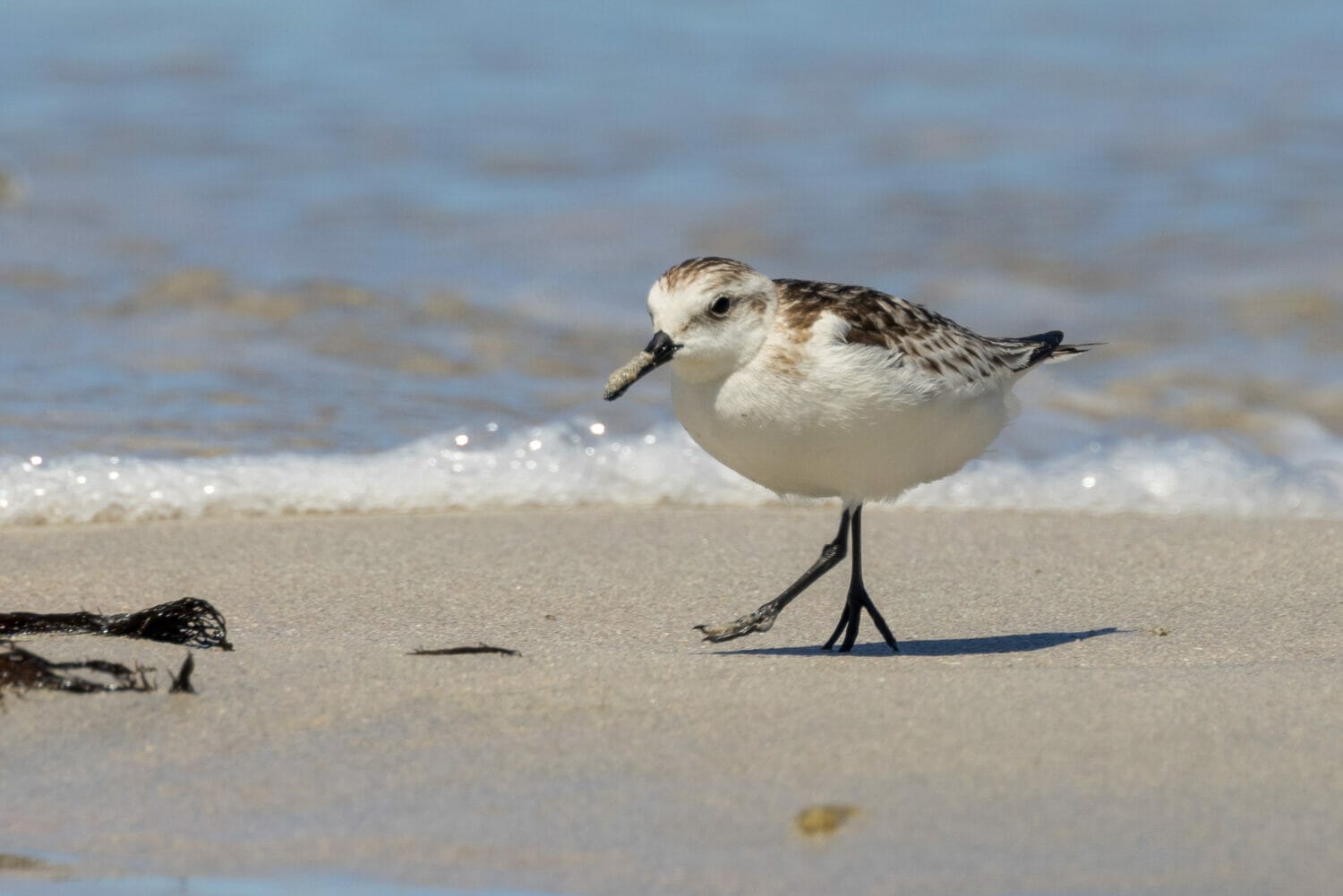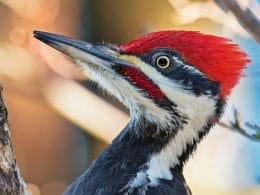If you have ever gone bird watching on the coast, you know that if you time it correctly you can see a wide variety of birds. So when is the best time for spotting shorebirds?
The best time to spot shorebirds is just around high tide. As the tide comes in, it pushes the birds up the beach. Then, the high water deposits a new batch of pickings for the shorebirds. As the tide retreats, the saturated sand in the shallows becomes loose. The loose sand is easy for the birds to probe for fresh prey with their sensitive beaks.
Shorebirds typically have relatively longer legs to allow their bodies to remain dry as they wade. Their toes are also longer to provide a larger footprint. This helps to prevent them from sinking into the soft mud and sand where they hunt. Many have longer beaks allowing them to penetrate deeper into the floor in search of a tasty morsel.
The silt and mud of the shallow waters is where the birds wade and sift the bed for food. Mollusks, worms, tadpoles, invertebrates, small crabs, and other crustaceans make up the shorebird’s staple diet.

Shorebirds of the U.S.A
Now that you know when is the best time for spotting shorebirds, let’s go over some top species. There are over 50 species of shorebirds found in the U.S. Shorebirds take advantage of almost every habitat where water meets land, not just on the coastline.
Black Oystercatcher (Haematopus bachmani)

Black Oystercatchers are a beautiful but uncommon sight in most of the U.S. The striking contrast of their glossy jet black plumage and bright red beak and eyes is easily identifiable. The American Oystercatcher is spotted more regularly. This white-breasted variety is just as beautiful with longer legs and a longer, more orange-colored beak.
Black-Necked Stilt (Himantopus mexicanus)

Author Note: Stilts, as their name suggests, are a very long-legged species of shorebird. The legs of our native Black-Necked Stilt are disproportionate even within the genus. On the rare occasion you see these graceful birds standing on dry land, they look as if they’d fall over in a breeze.
American Avocet (Recurvirostra americana)

The American Avocet is a large striking wading bird with 3 distinctive black and white stripes. It’s like the Adidas of shorebirds. The mature males of this dignified species have a dull red-brown neck and head. The long black beak has a slight upcurve reminiscent of a samurai’s katana.
Other Coastal Birds
There are many birds that live and visit our coastlines and the best time to view them can vary. Coastal habitats are as interesting and varied as the birds that call them home. Herons, ducks, bull sprigs, gulls, terns, raptors, waders and migratory birds can be found on almost any U.S. shoreline.

The best time to view coastal birds can rely heavily on the season, tides, and the time of day. Dawn and dusk light provides a wonderful ambiance for photography. These are the times that birds are most active around roosts and nests too.
Research the species that you hope to spot and the activity you would like to observe or photograph. If you wish to get shots of shorebirds feeding their young at the nest – the best time may rely on the tide.
If you wish to watch Terns diving into the waves, a high tide will probably be best. The water will be deeper closer to the shore, and as such the diving birds will be closer and easier to spot. In contrast, however, waders prefer shallow water, so the high tide will leave their hunting grounds flooded. You should also keep an eye for these species when asking “when is the best time for spotting shorebirds?”.
Waders
Coastal wading birds that roost along the coastline can be spotted best around high tide. As the tide comes in, the birds come closer to shore. At high tide wading birds often roost while their food is under deeper water.
As the tide goes out again, the birds return to their feeding grounds. The receding tide leaves rich pickings of disturbed and washed-up prey close to the surface. In some areas, the tide recedes so far that coastal flats can resemble barren plains. On misty mornings the scenes can be quite picturesque, in an alien planet sort of way.

Gulls
Gulls are tenacious, often relying on other species to drive their aquatic prey to the surface. These large birds are considered a pest by many, usually people on vacation. The sight of a gull stealing a beak full of french fries, or mugging a toddler for a hotdog, is common. But these voracious bullies have even been documented hunting and eating pigeons.

Herons and Egrets

Herons and Egrets can be found in many coastal regions the length of the U.S. The numbers are greater and there is a wider variety of species in the south of the country. But these tall graceful birds can be found on beaches, in reedbeds and estuaries as far north as Canada.
Coastal Raptors
There are a great number of places to spot predatory birds along our shores. Peregrine Falcons, Osprey, Red-Tailed Hawks, Gyrfalcons and Fish Eagles can be found in many coastal regions.

What Time is Best for Photographing Seabirds?
Photography is best in the morning and evening for that ‘golden hour’ light. Bright backgrounds can wash out the color of the subject, but silhouettes can make very evocative photos too. Fast shutter speed settings are essential to reduce overexposure, and for successful shots of birds in flight.
However, you can’t photograph anything if the birds are not there, so that is the most important thing. It can be frustrating trying to co-ordinate tide times, beach access, light quality and the presence of the birds.
But it is worth the effort. This photograph was taken of a Bar-tailed Godwit from a position further up the beach as the tide was pushing the bird up.

What Time of Year is Best to Spot Seabirds?
From late February birds’ drab winter feathers make way for bright mating season plumage. So you can avoid taking your camera out until the worst winter conditions have passed.
In mid to late winter algae blooms are more abundant in coastal waters. At the coldest time of year, life gravitates towards the warmer shorelines from the cooler deeper ocean. These algae blooms are the foundation of the food chain, attracting staples like anchovies and other larger species.
This coastal activity draws a number of birds to the shoreline that is usually found further out at sea. Migratory birds that leave our shores to roost can be found on our local coastlines from January through April.
The weather may be inclement in the late winter. But this is the time uncommon pelagic birds can be encountered on U.S coastlines. Auklets, Gannets, Kittiwakes, Pelicans, Puffins, Black Skimmers, and even the majestic Albatross can be spotted on rare occasions.

The Great Lakes
The Great Lakes can be a great place to spot shore dwellers, waders, ducks, and other aquatic birds. Some species in the area have become endangered due to increased human traffic and development. But conservation work is being carried out, and it is showing results.
Author Note: The Piping Plover is a rare sight these days with only 66 breeding pairs remaining on the great lakes. However, their dwindling numbers are said to be experiencing a slow but steady rise. These small birds nest in a shallow hollow dug in the sandy shore.

Piping Plovers rely heavily on camouflage. They seek large beaches with sparse vegetation and washed-up detritus in which to hide their simple nests.
The beaches of the great lakes are a popular vacation destination. With the increase of visitors over the years, there has been a steady decline in Piping Plover numbers. Noise and destruction of habitat has had a great impact. But most critically, these birds are totally unequipped to evade the domestic cats that invariably accompany human civilization.
Estuaries

There are many bird species that can be encountered on the shorelines where rivers meet the ocean. The brackish water in estuaries plays host to a unique ecosystem that survives in a mix of fresh and salinated water.
The silt deposited by a river often forms a tidal flat which offers birds a great place to find food. A river continually deposits fresh silt, flotsam, and debris into a tidal estuary. As the tides advance and retreat, the river’s leavings is claimed by the ocean.
The sea can also deposit and churn up edibles for shorebirds, such as crabs, shrimp, and other crustaceans. Various ducks, gulls, herons, and other waders can be found exploiting the riches of a tidal estuary.
The water life is varied and draws not only small fish, but larger predatory fish also hunt in these murky waters. Larger fish, in turn, draw larger birds. Fish eagles and other raptors can be seen gracefully plucking fish from the water.
Reedbeds
Various bird species thrive in the reedbeds that are found in many estuaries and shoreline wetlands. Whether floating or suspended above the waterline by intertwining the reeds; These dense reeds provide an almost inaccessible vantage to hide a nest.
This habitat is home to many types of insects, fish, amphibians, and invertebrates. The wide selection of food that is available for birds is another draw in addition to safe nesting sites. Reedbeds are a popular area for fish to spawn, and their newly hatched fry form a key part of the food chain.

The ecosystems of reedbeds have suffered from human innovation. Great areas in the U.K. and Holland have been drained for human habitation and farmland. The soil that remains after the water has been pumped out provides excellent arable land for producing crops. But sacrifices the wildlife that depended on the wetlands.
Author Note: Reedbeds provide a rich environment for copious species. The historical reclamation of wetlands from coastlines has caused concern for conservationists. There are now teams dedicated to building simulated wetlands in an effort to reintroduce natural wildlife.
Safety
Safety is another thing you should consider when figuring out when is the best time for spotting shorebirds. Remember walking on tidal flats poses dangers, especially in a foggy, featureless landscape. Sand flats can change to mudflats in a few steps. The sticky mud can remain hidden by a thin top layer of sand. Pitfalls flooded with sandy water can be almost indistinguishable from secure footing. Even a twisted ankle and fast inrushing tide can claim lives.
Tip; Coastal weather can change very quickly. If you do walk on coastal flats, try not to cross your own footprints. If a fog descends and the tide is coming in, you need to retrace your steps in a hurry. You can lose valuable time trying to figure out which trail leads back to dry land.
Conclusion
You don’t actually need to be close to the coast to see shorebirds. These delightful birds can be found on the shores of the great lakes and the banks of rivers dams nationwide. We hope you enjoyed this article on when is the best time for spotting shorebirds!
Fly high friends!

FAQ
This is a big group of birds. Shorebirds are classified as those which predominately seek food in coastal areas. There are around 217 species in the group and over 80 are seen in the U.S. They include sandpipers, plovers, phalaropes and stints.
I guess it really depends on where you are. Globally, the Sanderling (featured photo) probably has the most numbers.
Nothing! In the United Kingdom, shorebirds are known as waders.










